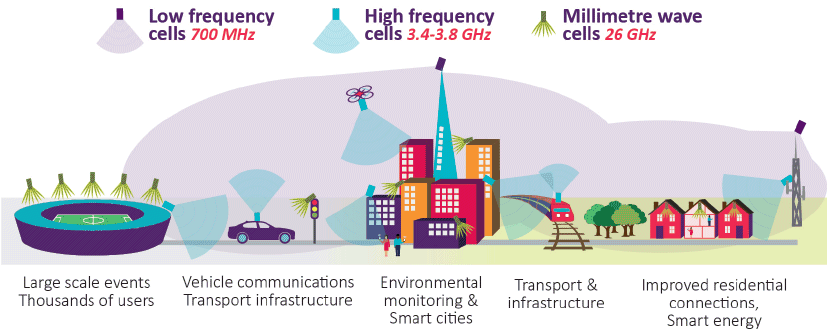Ofcom Set Ambition for 5G Spectrum and Possibly 6GHz Wi-Fi
The UK telecoms regulator has today published a new consultation document on their proposals for the crucial World Radiocommunication Conference 2019 (WRC-19), which amongst other things highlights the bands they’d like to see used for 5G and the possibility of adopting 6GHz for use in future WiFi networks.
The WRC event is held approximately every four years and enables countries to better identify, as well as harmonise, useful bands of radio spectrum. Ofcom notes that decisions taken at the conference “could affect thousands of UK businesses and consumers,” which makes it vitally important for all manner of wireless communication based services and technologies.
The next event will take place between 28th October to 22nd November 2019 and Ofcom has thus begun their preparations with a new consultation, which proposes a range of policies for how they could approach the spectrum governing various sectors, such as mobile broadband, maritime, aeronautical, satellite and scientific use.
Advertisement
In terms of future 5G mobile services, there aren’t too many surprises. So far Ofcom has already auctioned off the 3.4GHz band for 5G and we know they’ll do the same with 700MHz next year. On top of that they’re already looking at how to release spectrum in the 3.5-3.8GHz bands and also the 26GHz (24.25-27.5GHz) band for the same purpose.
The rationale is that 700MHz will prove useful for delivering wide 5G coverage in rural areas, albeit at slower speeds than urban areas (less opportunity for Carrier Aggregation etc.). Meanwhile the higher frequencies around 26GHz (e.g. millimetre Wave) will support “very large bandwidths, providing ultra-high capacity and very low latency“, although their limited range may confine them to fixed wireless networks. Finally, the stuff in 3.4GHz+ may work most of its magic in urban areas via a dense network.

On top of all that Ofcom’s new consultation identifies other bands that they “intend to promote” for similar uses in mobile networks.
Advertisement
Ofcom’s Statement
[The] other bands that we intend to promote for identification for IMT are; 40.5-43.5GHz (as part of the wider 37-43.5GHz band) and 66-71GHz.
As we said in our Call for Input and more recent Enabling 5G in the UK, we consider that the frequency range 37-43.5GHz has strong potential to become a 5G band, noting its attractiveness as a wide tuning range for harmonised equipment, while equipment development in 66-71 GHz should be able to draw on the experience of multi-gigabit wireless systems in the adjacent band.
The 66-71GHz band also appears to have no operating users and this spectrum has recently been opened in the USA for unlicensed use. Finally, the band 32GHz (31.8 – 33.4GHz) has also been discussed internationally, although there appears to be little traction on this band at present.
Further down in the document Ofcom notes that “more recently and outside the work preparing for WRC-19“, the 6GHz band (i.e. above 5925MHz) has come into focus for potential sharing opportunities with Wi-Fi or similar short range wireless broadband access technologies. Both Europe and the USA are known to be considering this.
“Ofcom will continue to monitor these [6GHz] developments to help us understand which of the bands of interest for potential expanded Wi-Fi use have the greatest prospect of support,” said the regulator. Ofcom has already given WiFi a boost by making an additional 125MHz of radio spectrum available to it via 5.8GHz (here), but the addition of a whole new band beyond the existing 2.4GHz and 5GHz spectrum would be a big change.
Certainly even the best home wireless networks tend to struggle with the new generation of Gigabit capable “full fibre” broadband ISP networks and so a new band sitting so close to the existing 5GHz one would be ideal, although various other satellite, fixed link and mobile style communication platforms already make use of it. We probably won’t see 6GHz being used by WiFi for awhile.
Ofcom’s 2019 WRC Consultation
https://www.ofcom.org.uk/../uk-preparations-wrc-19
Mark is a professional technology writer, IT consultant and computer engineer from Dorset (England), he also founded ISPreview in 1999 and enjoys analysing the latest telecoms and broadband developments. Find me on X (Twitter), Mastodon, Facebook, BlueSky, Threads.net and Linkedin.
« BT Sport Secure 20 Extra Premier League TV Footy Matches for £90m

















































Comments are closed